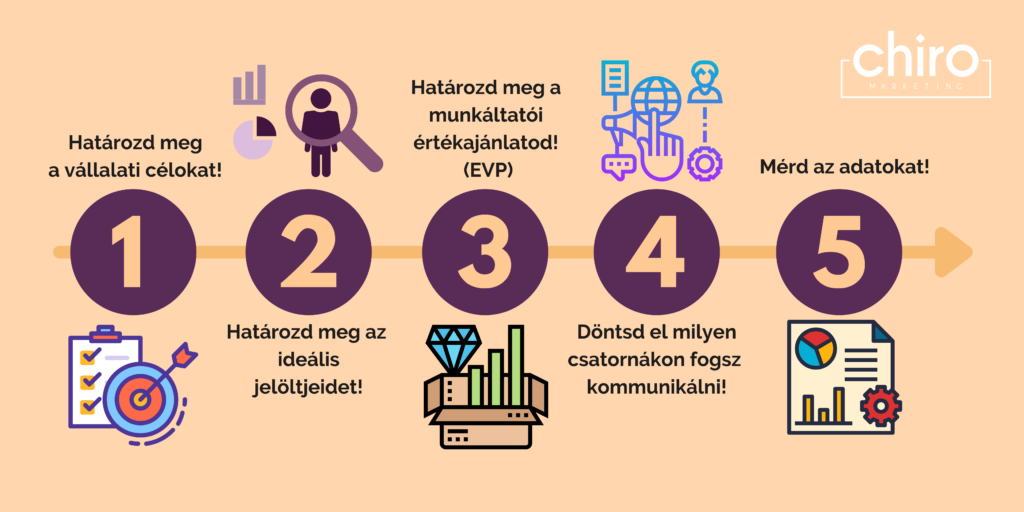In the past two years, finding and retaining the right workforce has become a central issue for companies. Covid has not only affected supply chains and revenues, but also had a major impact on the labor market: almost every company has been affected by fluctuation, recruitment difficulties, and employee retention. It is no longer enough to post a job advertisement to find a new professional, and it is not enough to raise the salaries of colleagues to keep them at your company. If you want to keep up with changes in the labor market, then employer branding is something you definitely need to pay attention to. And a good digital marketing agency can be of assistance.
What is employer branding?
In short: employer branding is the image that exists in the minds of your current and future employees about your company. This includes not only your job advertisements, but also your selection process, your social media posts, your employer value proposition, your motivational system, your internal communication, etc. It is a very complex area, essentially a combination of HR and marketing, in which the entire company culture also plays a role. A digital marketing agency can enhance these efforts by strategically positioning your brand online.
In the following 5 points, we will take a closer look at one aspect of employer branding, recruitment, and try to provide practical tips that can help you shorten recruitment time, reduce costs, and find higher quality labor.
The steps to develop an employer branding strategy for recruitment are as follows

Define the corporate goals!
What are your main goals? How many applicants do you want for your job postings? Do you want to attract the most talented employees in your field? Do you want to reduce the time and cost of the application process? Specifically, how many professionals do you want to hire, and what skills do you want them to have? Write down your expectations and goals in detail using the SMART method. This is important because it is easier to plan a path and solution for specific goals, and because only specifics can be measured and evaluated. (“Have good employees in my company” is not a good goal.)
Define your ideal candidates!
Without creating the persona of your ideal candidate, you will not be able to formulate messages that will attract the right people for you. At this point, feel free to apply the steps of creating a buyer persona. Here are the most important aspects:
- Who is your candidate? How old, where does he live, what is his family background, education, experience, where does he work, etc.
- What are his goals? Why does he want to change jobs? If he is a beginner, where does he come from?
- How does he look for a job? Through acquaintances? On the internet? At job fairs? Through employment offices? On what platforms?
- What are his personality traits?
- What motivates him? Higher pay? A noble cause? A new professional challenge? New colleagues and environment? Job security and predictability? (it’s better to ask your current colleagues about this)
- What is currently bothering him? What is the obstacle to leaving his current job, and how can you help him?
- What skills does he have? What specific areas does he have professional experience in? What problems has he solved so far?
- Who are those who can influence him? Friends, family? His current employer?
- What information reaches him, and what does he trust? Is it enough to post a job ad on Facebook? Will your company’s website be convincing enough? Could you personally connect with him at a professional conference? Or do you need to organize an open day?
Define your employer value proposition (EVP)
Why did your employees choose your company? What do they like most about you as their employer? For the employee you want to convince, why are you the best choice? (this is why it’s important to know what’s most important to them, see above). You need to have pinpoint answers to these questions in order to establish your employer value proposition. These answers will best define the EVP that you need to show and prove to ideal candidates. The 5 basic pillars of the value proposition are:
- Compensation: What payment structure do you use? How often are pay raises given? How does the pay at your company compare to others in your field?
- Benefits: Vacation, flexibility, insurance, medical care, retirement, gym membership, childcare, team building, education. What can you offer to make your employees’ lives better?
- Career: The “development opportunity” that is mentioned in every job posting, how is it realized at your company? Do you support your colleagues’ development at all? How attractive is your company to a beginner? How clear is it what career path can be taken, what are the steps, and where is the limit?
- Workplace environment: Is there recognition, if so, how? How much do you support each other? What is the relationship between colleagues like? Is it more familial or more like a multi? How much autonomy do employees have? How much do you recognize individual performance? Is there time for personal life alongside work?
Work culture: Is everyone aware of the goals? What is teamwork like? Are the leaders competent? Can you turn to them? Are they so good that others look up to them and want to learn from them? Do the team members trust each other?
4. Determine which channels you communicate your employer brand through
Until an applicant goes from applying to being hired, they typically interact with your business in some form about ten times (landing pages, application-related emails, online phone interviews, etc.). This means you have ten non-returnable opportunities to make the right impression on the applicant. Sound familiar? The customer funnel works on the same principle.
Now all you have to do is thoroughly map out the candidate’s journey and tailor your strategy accordingly. Point 2 will also help you: if you know where the ideal employee gets their information, you need to be present there. Even if TikTok and Instagram are trendy, if you’re looking for senior engineers, these won’t be your platforms. You can also consider offline channels, especially for reaching certain target audiences, such as blue-collar jobs where giant billboards and citylight posters can be extremely effective. Engaging with a digital marketing agency can help you effectively navigate and utilize these channels.
Measurement, measurement, measurement
In today’s data-driven world, we measure everything, and we have data on everything. This is no different for employer branding. Let’s go through what you should pay attention to.
- Feedback from your employees
On the one hand, this is the best indicator of your employer brand, and on the other hand, this is what potential candidates consider the most credible and actively seek out online (and offline) before accepting a job, so it is a very effective and cost-effective way to build your employer brand.
- Number of submitted resumes/applications
This is a simple measure: how many people applied for the job. But don’t just measure how many applied, also check how many were truly relevant. (There are always those who don’t meet any criteria and just happened to get into the process; they shouldn’t be counted in the results.)
- Ratio of offered positions/accepted positions
A strong or strengthening employer brand is characterized by the continuous improvement of this ratio. If this is not the case for you, it may indicate that there is a problem with the application process, or even worse, with your employer brand. It is important to find out why they ultimately declined your job offer, which company they chose instead of yours, and why.
And still more measurement
- How much time elapses from applying for the job to accepting the job
According to LinkedIn statistics, a strong employer brand can reduce this time interval by up to 200%. This is logical, as the less time you have to spend introducing your company, the faster you can select the most suitable candidate from the applicants.
- Attrition rate
Colleagues come and go, this has always been the case, especially in a dynamically changing market. However, if more and more people are leaving you, it may mean that they were not able to commit to your employer brand as you expected, something went wrong somewhere along the way. Make it a habit to interview departing employees, from these you can find out where, in which areas you still need to improve.
- Source of job applicants
Where did the candidates come from, from which channel did they come to you? Where did they first hear about you? It is important to rank the channels based on efficiency, so you can find out which ones are worth focusing on more, if there is one that is worth investing more energy into, or one that does not bring any results and it would be better to let it go. Consulting with a marketing agency in Budapest can offer local insights and effective strategies.
A vision is needed
According to a Glasdoor survey (the survey was conducted in the United States, the United Kingdom, Germany, and France), 77% of people thoroughly research the corporate culture before taking a job. 79% of them are greatly influenced by the company’s vision and goals, and half of the 5,000 respondents believe that the quality of the work environment is more important than the pay itself.
It’s not enough to acquire, you have to retain
Losing an employee in whom you invest money, time, and energy always results in a significant loss in terms of time, energy, and finances.
With a well-structured employer branding, however, you can greatly reduce corporate attrition. By following the steps outlined in the article, you can develop your own, but if you feel you need help, a digital marketing agency, like Chiro can also assist in refining your strategy. You can contact us here!
If you found the article useful and think others would too, I’d appreciate it if you shared it!




